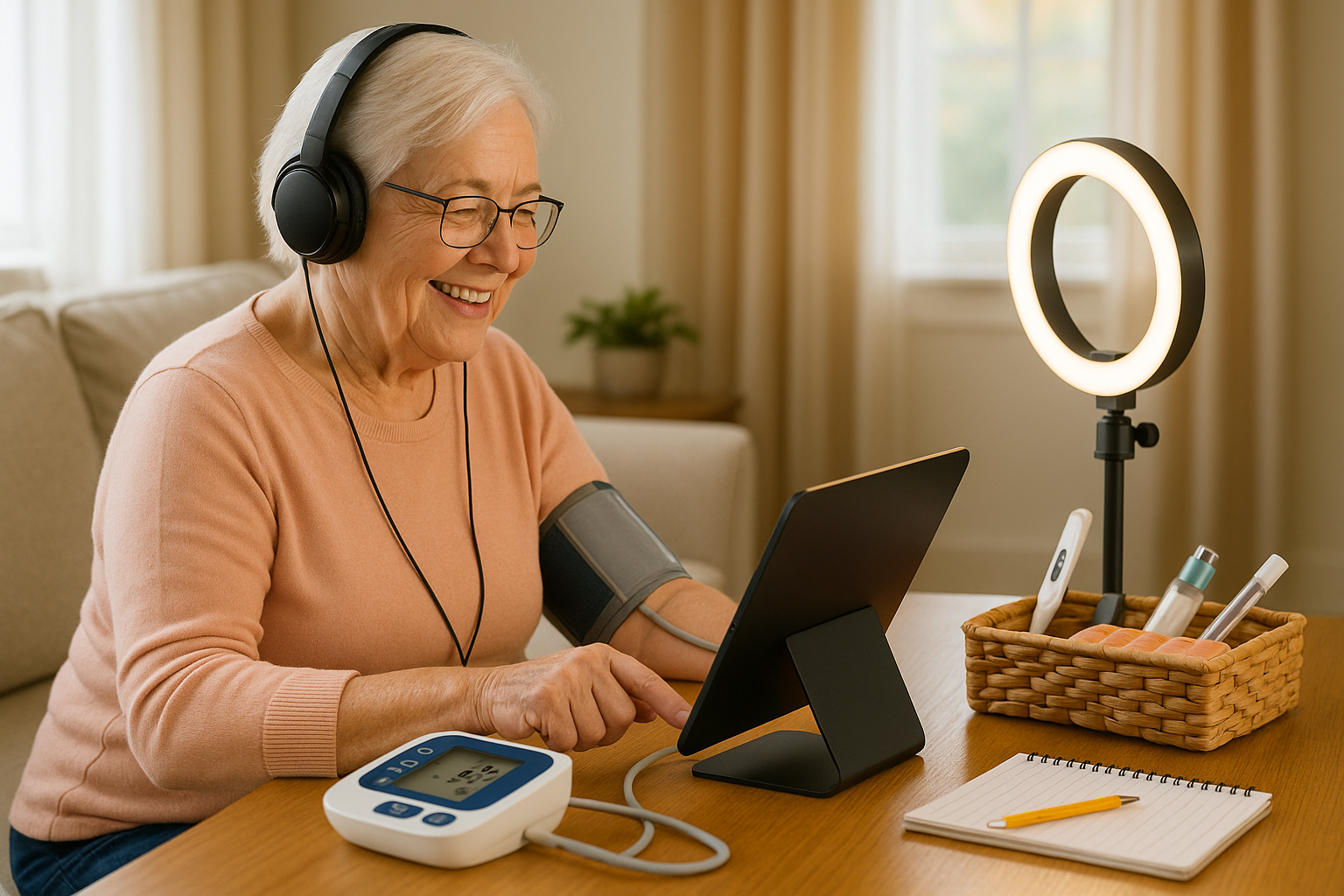Best Devices for Seniors Using Telehealth
- Home
- Best Devices for Seniors Using Telehealth

Best Devices for Seniors Using Telehealth
Estimated read time: 7 minutes
TL;DR: A simple setup works best: a 10-inch tablet (or larger), stand, good lighting, and comfortable headphones. Add a few home health tools (upper-arm blood-pressure cuff, thermometer, pulse oximeter, scale). Turn on accessibility features (big text, captions, hearing-aid pairing), and keep everything in a telehealth basket so visits are easy.
The essentials (what you actually need)
1) A simple video device
- Best all-around: a tablet with a 10–11″ screen. Easier to hold than a laptop; bigger than a phone.
- Also fine: a laptop (built-in camera) or a smartphone (works, but small text).
- What to look for:
- Clear front camera and loud speakers
- Long battery life and charging cable that reaches the chair
- Wi-Fi that stays connected (5 GHz helps if you have it)
- Big, bright screen; easy to make text larger
2) A steady view
- Sturdy stand or case that props the device at eye level
- Optional flexible gooseneck arm if neck/shoulder movement is limited
3) Clear sound
- Over-ear headphones are easiest to hear and reduce echo
- If using hearing aids, pair by Bluetooth when possible
- Turn on captions if available during the call
4) Good lighting
- Sit facing a window or lamp; avoid bright light behind you
- A small clip-on ring light can help if the room is dim
Helpful home health tools (telehealth-friendly)
Keep these in a small basket near the chair so they’re always ready.
- Blood pressure monitor (automatic, upper-arm, correct cuff size, big display)
- Thermometer (digital)
- Pulse oximeter (reads oxygen and pulse; look for large digits)
- Weight scale (large, non-slip platform, big numbers)
- Glucose meter or CGM (if you have diabetes)
- Inhaler + spacer (for asthma/COPD)
- Pill organizer and updated medication list
Accessibility settings that make calls easier
- Bigger text & icons: increase display size; use “bold text”
- Louder audio: turn on “hearing accommodations,” enable mono audio if one ear hears better
- Captions/subtitles: system-wide or in the app
- Screen magnifier or zoom for small details
- Voice assistant to place or answer calls hands-free
- Caregiver shortcuts: simplified home screen with only the clinic app, phone, and messages
Quick picks by situation
- Low vision: larger tablet (11–13″), high-contrast theme, bold text, screen magnifier, bright front lighting
- Hearing difficulty: over-ear headphones or hearing-aid pairing, captions on, quiet room
- Hand tremor/limited grip: stand + wide “answer” button on screen; consider a stylus
- Neck/back pain: gooseneck arm so the camera sits at eye level without bending
- Memory concerns: simplified home screen, printed “Tap here to start” card next to device, caregiver’s number on speed dial
Build a “telehealth station” (5 minutes)
- Place a chair near an outlet and Wi-Fi router (strong signal).
- Put the tablet/laptop on a stand at eye level; plug in the charger.
- Add your basket: BP cuff, thermometer, oximeter, pill organizer, medication list, notepad, pen, glasses, hearing aids/charger, and headphones.
- Tape a one-page checklist to the wall (see below).
Pre-visit checklist (print this)
- Device charged and on the stand
- Wi-Fi connected; other streaming paused
- Camera & microphone allowed for the app
- Headphones/hearing aids ready; captions on if helpful
- Medication bottles/list within reach
- Today’s readings (BP, glucose, weight, oxygen, temperature)
- Top 2–3 questions written down
- Pharmacy confirmed
Troubleshooting in 30 seconds
- No sound: raise volume; unmute the little mic icon; try headphones
- They can’t see you: tap the camera icon; clean the lens; close other apps using the camera
- Choppy video: move closer to the router; ask others to pause streaming; switch to audio if needed
- Lost the link: open the patient portal → Appointments → Join
Safety & privacy basics
- Use the clinic’s official app or website only
- Don’t share passwords or full Social Security numbers on a call
- Lock screen with a passcode; sign out of the portal after visits
- Invite only trusted people into the room or video
When telehealth is not enough
You’ll still need in-person visits for vaccines, lab draws, X-rays, ECGs, Pap tests, mammograms, and procedures—or anytime symptoms are severe or sudden (chest pain, trouble breathing, one-sided weakness, heavy bleeding, new confusion). Call emergency services when needed.
How SendClinic can help
- Setup help and a quick test call if you’d like
- Same-day video visits for common concerns and refills
- Clear written instructions after each visit
- Follow-ups so nothing falls through the cracks
Educational content only. This article isn’t a substitute for medical advice. Always follow your clinician’s guidance and local emergency instructions.
- Share